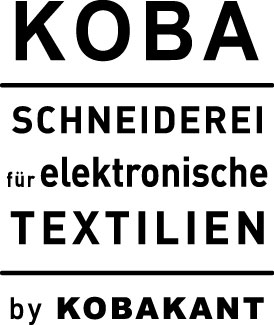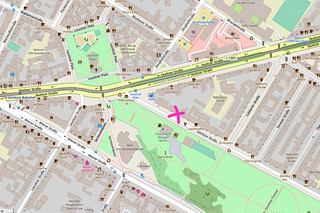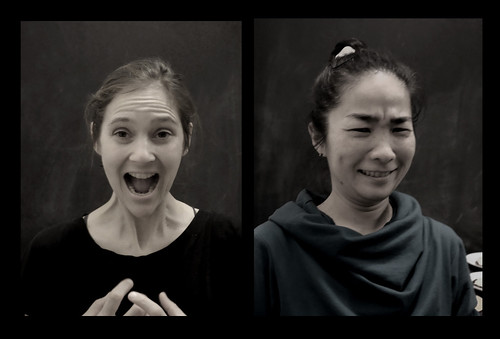Lulu collaboration with Maurin
For 2018 we plan a collaboration with Maurin Donneaud to figure out a toolset and workflow that brings together the worlds of electronic textiles and fiber optic illumination.
Lulu is a hardware solution that interfaces between an LED light source, an optic fiber strand or bundle and soft circuit connections. Providing an optic fiber connection toolset and workflow for E-Textiles and Wearable Technology applications.
Project Description
In the field of E-Textiles and wearable technology, many designers use light illumination as a dynamic design element. Use of fiber optics with LEDs is one of the most common methods for embedding light into textile designs. Despite this demand for fiber optic textile integration, there are no ready-to-use toolsets for making the connection between the textile electronic circuitry and the light source for illuminating the fiber optics that are robust and suitable for the use with textiles in a wearable technology context.
We propose to design, test and produce a manufacturable PCB and connector design for connecting optic fibers with LED light sources. This design needs to be robust, durable, washable, comfortable. The design must withstand the requirements of being embedded into textiles, with sewable electrical connections that suit e-textile soft circuitry practices (conductive threads, fabrics, fibers) and resilient against the wear that comes from being worn on the body in daily life.
We will:
1) Designing a sewable/E-Textile soft circuitry suitable PCB with LED light source and custom connector
2) the custom connector design will connect the light source with the end of optic fiber strand
3) a corresponding connector design for optic fiber end
4) designing a communication bus system to control the behavior of the light on the PCB
5) demonstrating various use-cases as part of the KOBA E-Textile tailor shop through real customer commissions and collection items
Lulu_Pitch from Donneaud Maurin on Vimeo.
Motivation
Use of light in textile and fashion design is becoming more and more common and many schools (i.e. Weissensee Art Academy, Swedish school of Textiles) started to teach this subject as a part of their textile design curriculum. Optic fibers could be embedded in textiles as embroidery, in weaving, knitting and knotting process and many innovative textile designs have been realized in recent years. But often the designers lack the toolset for connecting the light sources with the embedded optic fibers, resulting in re-purposing bulky connectors and technology and hiding them behind the textiles. Currently there are no such toolsets and instead each designer has to come up with their own re-purposed or DIY solution. Unreliable connections between fiber optics and light source result in poor illumination of the fiber. What Lulu provides is a simple, reliable toolset for E-Textile designers to work with fiber optics design. Instead of struggling to solve the light source and connection problem, the designer can concentrate in the aesthetic issues in the design process. The communication bus system will make it easy to use multiple light sources and program their behavior. As Lulu is small, light and sewable PCB that is suitable for soft circuitry, the entire electronics can be embedded in textile, making it flexible and wearable.
The outcome of the Lulu project will benefit current E-Textile and wearable technology designers who work with fiber optics embedded designs, as well as educational field of these designers (i.e. smart textile course at universities) as it will make it much easier to teach the use of fiber optics.
For distributing the finished Lulu product, we want to collaborate with online distributors and local retailers so that the outcome is purchasable by anybody looking for this kind of solution.
Relevance to the field of E-Textiles and Wearables
In the field of Electronic Textiles (E-Textiles) and Wearable Technology (Wearables), being able to sense and actuate materials, as well as transmit data through materials, are some of the main fields of research. Optic fibers are extruded nylon filaments that are efficient at transporting light within their core. They are interesting for use in E-Textiles because they are long, thin, flexible and relatively robust, meaning it is possible to integrate them with many existing textile techniques.
Text from video:
“Lulu is a connection solution that brings together the worlds of electronic textiles and fiber optics. Electronic textiles is a field of research and production that looks at embedding electronic functionality directly into textile materials. Fiber optics are extruded nylon strands that are very efficient at conducting light from one end to the other and are mostly used in high-speed data communication where data is transmitted using light as the medium.
Lulu is a connection board that allows you to sew the electrical connections to control the LED light that is then shining through the fiber optic cable. The Lulu PCB has sewable connections for the electrical lines and a custom socket for connecting to the end of the optic fiber right in front of the LED.”
Objectives
Our objective is to collaborate to produce a manufacturable design for LED lighting connection between soft circuitry and optic fibers. To demonstrate this design in practice by producing a series of examples and tutorials. To collaborate with manufacturers and distributors to make this design available to makers, designers, engineers.

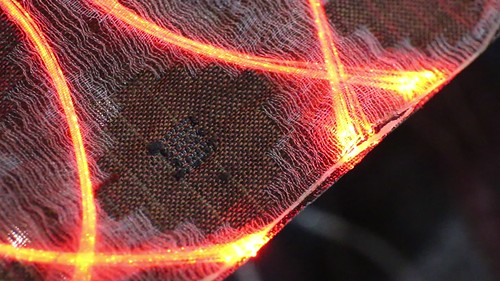
Lucette fiber optic woven fabric by Maurin Donneaud – and example of Lulu application in E-Textiles
More photos of Lucette >> https://www.flickr.com/photos/maurin/albums/72057594109320583
In the field of Electronic Textiles (E-Textiles) and Wearable Technology (Wearables), being able to sense and actuate materials, as well as transmit data through materials, are some of the main fields of research. Optic fibers are extruded nylon filaments that are efficient at transporting light within their core. They are interesting for use in E-Textiles because they are long, thin, flexible and relatively robust, meaning it is possible to integrate them with many existing textile techniques.
The Lulu is a hardware design solution that connects the end of an optic fiber with an LED light source and breaks out the electrical connections of this LED for connecting with soft circuitry (conductive fibers, fabrics, threads…).
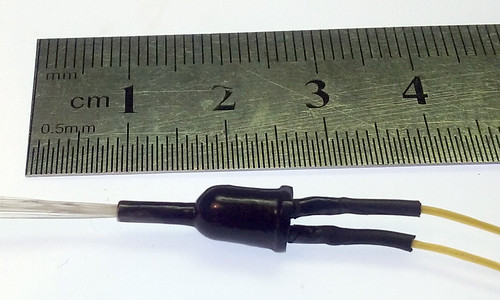
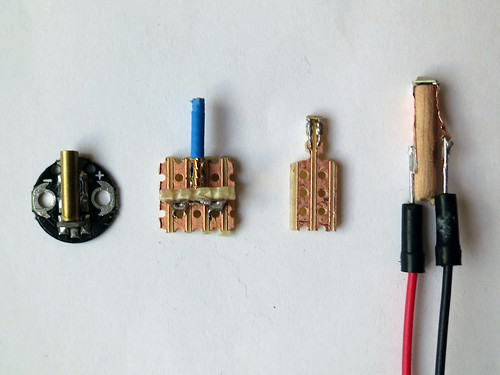
Lulu compared to other DIY connection solutions between SMD LEDs and optic fiber ends
Extended objectives
While with this Lulu proposal we are focussing primarily on the use of optic fibers for optical actuation (emitting light for visual purposes), this same solution could also be used for data communication over light (LEDs can also be used as Light Dependant Resistors LDRs), as well as bend sensing, since light is lost when then optic fiber is bent. Mounting a light sensor (or using the LED as a light sensor) at the opposite end of the optic fiber and measuring how much light comes back it is possible to use the fiber as a bend sensor.
Light Emitter: illuminating optic fibers (sideglow) for visual effect by treating the optic fibers such that light emits from their sides.
Data Transmitter: data communication between the ends of the fiber, and along the length of the fiber.
Bend Sensor: sensing bend of optical fibers by mounting a light source on one end of the fiber and a light sensor on the other and measuring how much light reaches the sensor. This works because light is lost when the fiber is bent.
Target Audience
Many designers use light/illumination as a part of their dynamic design element. Use of fiber optics with LEDs is one of the most common methods for embedding light in E-Textile designs.
People who will benefit from this work include: artists, designers, engineers, educators, students, makers… working in the fields of E-Textiles and Wearable Technology.
Benefits for Target Audience
This design will provide a robust, durable, washable, comfortable solution for working with light and optic fibers in E-Textiles and Wearables. The design will withstand the requirements of being embedded into textiles, with sewable electrical connections to suit E-Textile soft circuitry practices (conductive threads, fabrics, fibers) and resilient against the wear that comes from being worn on the body in daily life.
Innovation
There are currently no off-the-shelf solutions for making the connection between the end of the optic fiber and the LED light source that are suitable for use within E-Textiles or Wearables. The Lulu will provide this solution to anybody needing it.
Current State of the Project
The idea for this project came from Maurin Donneaud in 2016, and was first realized as a swatch for the 2016 eTextile Summer Camp Swatch Exchange (http://etextile-summercamp.org/swatch-exchange/lulu/). KOBAKANT first used this first version Lulu for their KOBA opening collection items “Poetry in Motion” (http://www.kobakant.at/KOBA/ohne-mich/). Using the Lulu v1 allowed us as designers to quickly test, prototype and produce the final pieces, concentrating on the esthetic layout of the fiber and the design of the light behavior.
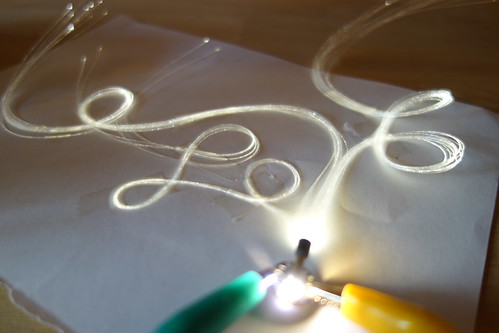
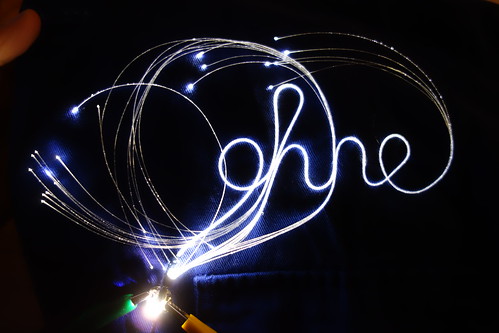
Prototyping layout of the optic fibers with the Lulu and tape on paper
The v1 prototype illustrates the potential of it becoming a fiber optic toolset for E-Textile projects. Bellow you can see the Lulu in the final “ohne mich” design with a single strand of 1.5mm diameter sideglow optic fiber embroidered into the overlaid words “ohne” and “mich”. Only when the words illuminate (one after the other) is the viewer able to identify the individual words.
More photos of “ohne mich” >> https://www.flickr.com/photos/plusea/albums/72157691569545895
“ohne mich” Video >> https://www.youtube.com/watch?v=15F0lIdbAXM
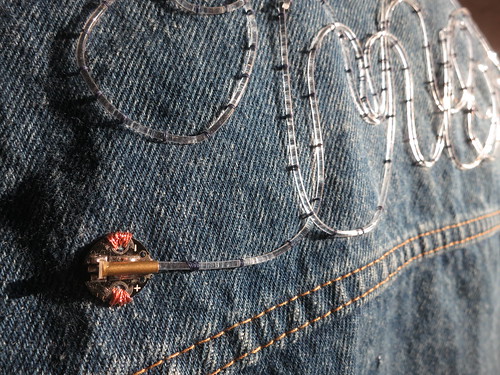
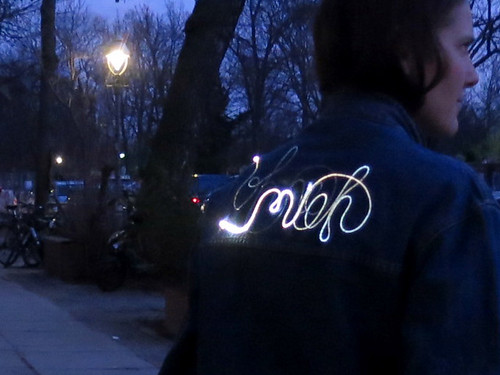
The Lulu used in the KOBA opening collection example Poetry in Motion “ohne mich”
The current v1 prototype needs to be assembled by hand in a labor-intensive process due to the non-industry standard placement of the LED. Therefor it is not possible to pick-and-place assemble and affordable distribute the current design to a larger audience. The WORTH funding will help us improve many such aspects of this design, bringing it to a manufacturable state with new PCB design, LED solution and the connector design to suit the industrialization process.

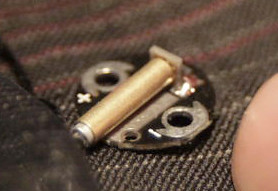
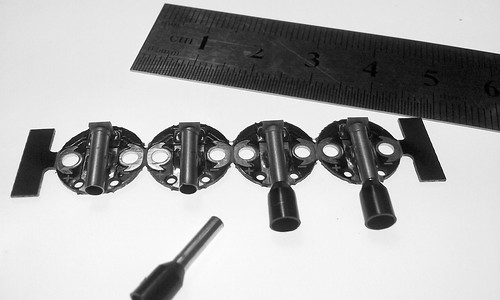
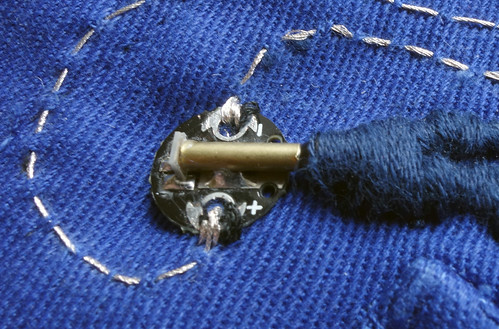
Lulu PCBs being assembled and close-up of a Lulu with electrical connections sewn with conductive thread
Documentation of previous v1: http://etextile-summercamp.org/swatch-exchange/lulu/
Previous design files: https://github.com/MaurinElectroTextile/Lucette/tree/master/Eagle/Lulu
New design v2: https://github.com/MaurinElectroTextile/Lucette/tree/Lulu_MCU
Goals
Industrialization (industrially manufacturable design)
Attractive for wearables
Improve connectivity between electronics and textile
Optimizing heat dissipation
Add communication bus system to reduce interconnections
The PCB design will fit a three lines E-textile bus
Issues to resolve:
>> https://github.com/kcuzner/onewire-leds/issues/1#issuecomment-351913753
Sustainability – economic, environmental, social
Open Source Hardware
We will be publishing all of our work as Open Source Hardware (OSH). OSH technologies ( https://www.oshwa.org/ ) promote an ethical practice which results in the development of technologies that are more relevant to local ecosystems, and local facilities.
Environmental Production
We want to collaborate with a PCB manufacturer producing using environmentally conscious methods. As part of this project we want to inform ourselves of the options.
Commercialization Plans
Push the project towards commercialisation by contacting distributors to produce and retail the Lulu solution.
Aisler: small-scale hobbyist electronics manufacturer near berlin (https://aisler.net/)
Watterott: small-scale hobbyist electronics manufacturer in germany, it is also an online shop for electronics and can be a distributor (http://watterott.com)
KOBA: real shop in Berlin
Sparkfun and Adafruit retailers across europe:
>> https://www.sparkfun.com/distributors
>> https://www.adafruit.com/distributors
Introducing the Collaboration

Maurin Donneaud
Specialized in interaction design and physical computing, I develop projects between crafts and technology. One of my researches consists in rehabilitating gesture into digital media handling, to enrich Human Computer Interaction and enhance crafts through the use of smart technology. Therefore I collaborate with technicians, artists, researchers, fashion designer and textile companies. Involved in textile design schools such as ENSCI (Paris – France), ENSAD (Paris- France), ENSAAMA (Paris – France), ESBA (Le Mans – France), I share my knowledge to contribute into eTextile development projects and highlight the richness and creative potential of this practice.
Background: Graduate in industrial design, ENSCI-Les Ateliers (Paris – France), specialized in eTextiles, Maurin is working as freelance designer since 2005. Maurin is the co-fonder of Datapaulette eTextile Paris hackerspace.
http://datapaulette.org/
Collaboration Experience: Maurin develop eTextiles solutions since more than ten years. his personal practice stimulate many collaborations and projects with companies and people who share this passion:
– PSA Peugeot Citroën, luminous textiles and textile sensors for automotive market. (2016-2017).
– Doublet, connected floor slabs for events and scenography (2015).
– Nestlé, connected T-shirt for an advertising campaign (2015).
– General Electric-Healthcare, eTextile Giant Keyboard for persons with disabilities (Boston, 2011).
http://maurin.donneaud.free.fr/
https://www.flickr.com/photos/maurin/
http://etextile.org/
KOBAKANT: Mika Satomi & Hannah Perner-Wilson
Mika Satomi and Hannah Perner-Wilson have been collaborating since 2006, and in 2008 formed the collective KOBAKANT. Together, through their work, they explore the use of textile crafts and electronics as a medium for commenting on technological aspects of today’s “high-tech” society. KOBAKANT believes in the spirit of humoring technology, often presenting their work as a twisted criticism of the stereotypes surrounding textile craftsmanship and electrical engineering. KOBAKANT believes that technology exists to be hacked, handmade and modified by everyone to better fit our personal needs and desires. In 2009, as research fellows at the Distance Lab in Scotland, KOBAKANT published an online database for sharing their DIY wearable technology approach titled HOW TO GET WHAT YOU WANT.
In 2017, KOBAKANT has received WEAR sustain funding to realize an eTextile tailor shop. The project is currently running in Kreuzburg Berlin.
Wearable Technology art collective (since 2006): http://kobakant.at/
Open Source documentation (since 2008): http://howtogetwhatyouwant.at/
E-Textile Tailor shop (since 2017): http://kobakant.at/KOBA
Backgrounds
KOBAKANT
We have been working in the field of E-Textiles since 2006, starting with our first collaborative project “Massage Me” (http://massage-me.at/), an E-Textile game controller vest with embedded textile buttons. Ever since then we have been researching, experimenting and publishing our E-Textile and Wearable Technology documentation online at HOW TO GET WHAT YOU WANT (http://howtogetwhatyouwant.at). On the KOBAKANT website we publish our artistic and design work (http://kobakant.at) which includes works like “The Crying Dress”, “Involving The Machines” and “WishLab”.
Through our practice we have been collaborating with other artists, designers, engineers and performers. The most recent of these include:
Mi.mu gloves for music >> http://mimugloves.com/
Interactive Calligraphy & Sound Performance >> http://www.nerding.at/linlow-towards-transcendence/
Our Past Collaboration Experience
We both have experimental approaches to developing new technology and applying it for personal, expressive, performative applications. Although we work well together, we have not had the chance to work together in this capacity with the goal to develop and release a product like this. Both partners work in the field of E-Textiles for over 10 years as designers, engineers and also as educators. They have often published their work in the scheme of Open Source / Open Hardware and contributed in the knowledge building of the field. The previous collaboration of the partners not only benefited themselves as project production, but also have also contributed to the field in the form of open source designs, educational materials and online tutorials/documentation.
Our past collaborations have been in e-textile projects during various events (conferences, summercamps festivals). On these occasions we’ve worked together to engineer technologies and develop concepts for textile interfaces, wearable technology costumes and renewable energy solutions. Much of this work was done in open-ended, experimental, artistic and performance-based contexts:
Collaboration at E-Textile Summercamp 2014: DIY solar cells (http://etextile-summercamp.org/2014/blackberry-textile-solar-cell/)
Collaboration at Schmiede 2014: head-mounted drum machine sensors and e-textile dataglove (https://www.flickr.com/photos/plusea/albums/72157647135008080)
Collaboration through E-Textile Swatch Exchange 2014-2017: exchange of physical work samples in the field of electronic textiles (http://etextile-summercamp.org/swatch-exchange/)
Collaboration at E-Textile Summercamp 2017: tribal costume with wearable technology and speculative performance
